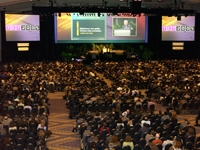Faculty at Weill Cornell Medical College demonstrated live (via satellite) several cutting-edge procedures on October 18, to the 17th Annual Transcatheter Cardiovascular Therapeutics (TCT) symposium in Washington, D.C, showcasing their expertise in these life-saving operations.

Physicians demonstrate (via satellite) various cardiovascular procedures at the 17th Annual TCT conference in Washington, D.C.
TCT, sponsored by the Cardiovascular Research Fund (CRF) is the largest interventional vascular meeting in the world, including an audience of nearly 12,000 this year from across the globe. CRF is affiliated with NewYork-Presbyterian Hospital, the chief clinical partner of the Medical College. Held over one week in Washington, D.C., the annual meeting demonstrates live cases, educational sessions, scientific symposiums and vendor exhibits.
Dr. Mun Hong, associate professor of medicine; Dr. Howard Riina, associate professor of neurological surgery and neurological surgery in radiology; Dr. Y. Pierre Gobin, professor of radiology and radiology in neurological surgery; and Drs. Vallabh Janardham and Jeffrey Katz, clinical fellows in radiology, led the first broadcast procedure, opening the carotid artery to restore blood flow with a stent delivered at the end of the catheter.
Whether intended to open a blocked artery of the heart or the brain, the procedure begins in the same manner. With the patient under local anesthesia, a catheter is inserted into the femoral artery near the groin to prepare for a diagnostic angiogram. The surgical team can thread the catheter either to a coronary artery that feeds the heart or to a carotid artery that nourishes the brain. A balloon can then be inflated to expand the blocked artery. A stent, which is a flexible, coiled metal tube, is placed to keep the artery open, maintain unimpeded blood flow, and thereby reduce the chance of a heart attack or stroke.
"Carotid stenting is a procedure that we have been using more and more as an alternative to carotid endarterectomy, which uses invasive surgery to remove plaque and open the artery," said Dr. Dana Leifer, associate professor of neurology and director of the Stroke and Neuroscience Step-Down Unit at Weill Cornell. The stent leaves minimal scarring, since its insertion in the femoral artery entails just a tiny hole in the skin. Dr. Leifer, who treated the patient prior to the stenting, emphasized the importance of a multi-disciplinary approach in treating stroke patients. Prior to stenting, the patient was treated emergently by Weill Cornell's Acute Stroke Team with tissue plasminogen activator (TPA), a drug that dissolves the blood clots that close arteries completely when there is a partial blockage caused by plaque. Dr. Leifer explained that the stent should keep the carotid artery wide open and prevent another stroke. He added that long-term control of blood pressure, cholesterol levels and diabetes is also essential to reduce the risk of additional strokes or heart attacks.
"We're a premier center for interventional radiology and cardiology," said Dr. Katz, citing the Medical College's newly updated angiogram suite with state-of-the-art equipment. Strokes are a major health problem, he said—the third leading cause of death in the United States and a leading cause of serious, long-term disability. On average, someone suffers a stroke every 45 seconds.
A team led by Dr. Shing-Chiu Wong, associate professor of medicine and director of the Cardiac Catheterization Laboratory in the Greenberg Division of Cardiology, and Dr. Manish Parikh, associate professor of clinical medicine, conducted the second broadcast procedure, which starred a drug-eluting stent called Zomaxx, which is currently awaiting FDA approval, to deliver a drug to prevent restenosis, or reclogging of the coronary artery. NewYork-Presbyterian Hospital makes use of two FDA-approved drug-eluting stents by Johnson & Johnson and Boston Scientific.
"The drug-eluting factor is part of the next generation of stents," said Daniel Splitgerber, R.N., director of patient care in the critical care and catheterization lab. Weill Cornell was ideally positioned to present this stent, he said, because "our interventionalists are among the most renowned in the world."

Nearly 12,000 participants attended the TCT conference.
Finally, Dr. Wong's team presented new techniques in TCT intervention—positioning of the stents and wires delivered via catheter—through a procedure treating multi-vessel disease, which demands multiple stents to achieve the best results. Multi-vessel disease, common in diabetics, is among the most challenging cases of intervention, and therefore an apt showcase for the range of new tactics.
Overall, the demonstrations highlighted the procedures as an alternative and at times superior option to bypass surgery, Splitgerber explained. "The patient returns home the next day, with minimal scarring and shorter recover time," he said.
Photos courtesy of the Cardiovascular Research Foundation.

